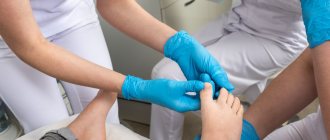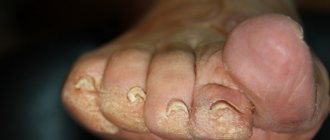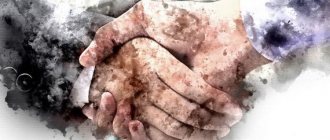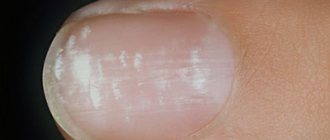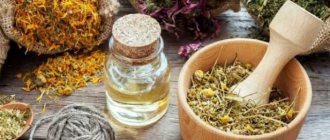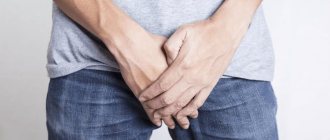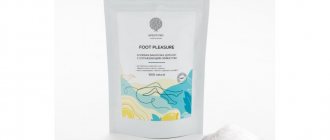Visual changes in the condition of a manicure or pedicure always frighten girls, since it is quite difficult to understand the reason for their appearance. The formation of yellow plaque on the nail plates of the feet is quite common, so it is important to know the main reasons for their formation.
However, sometimes it is difficult to understand why your toenails turn yellow on your own, especially if the problem is in the body. To do this, you should consult a doctor to diagnose it and prescribe treatment.
What is yellow nail
The yellowness of the nail plate on the hands and feet is a consequence of exposure to any unfavorable external factors, which subsequently lead to pigmentation. Some people are born with a specific nail color that can range from yellow to a distinct orange, but in this case this color is normal. It happens that the color changes and begins to peel off from the nail bed due to loosening the structure of the nail plate, in which case you need to check for fungal infections.
Call your doctor or nurse if you have:
- temperature rises to 100.4°F (38°C) or higher;
- chills.
- worsening of any symptoms;
- have any of the following symptoms around or under the nail: hot, hard, or painful skin;
- bright yellow or green discharge;
- bleeding;
- unpleasant odor;
- increasing redness or swelling;
- increasing pain or discomfort;
- redness;
to come back to the beginning
Why do the nails on my big toes turn yellow?
There are many reasons why a yellow toenail appears. At the same time, both men and women suffer from this problem for completely different reasons:
- Often, yellow toenails form when the patient has acute or chronic liver disease. In this case, an uncharacteristic shade of the nails first forms, and then the color of the whites of the eyes and skin becomes yellow.
- Imbalance of microflora. A lack of beneficial microorganisms in the stomach can lead to yellowness and diseases of the internal organs.
- The presence of a fungal infection. In this case, the plate on the toe looks painful, takes on an uncharacteristic color, and the tissue structure of some areas of the nail plate begins to change.
- Middle-aged and elderly people may experience the so-called yellow nail syndrome. In this case, the toenails begin to peel, thicken and change color.
- If the toenail turns yellow and becomes thicker, this may be a consequence of diabetes mellitus or other pathologies, such as psoriasis.
- The plate may become yellow and thick when the immune system is reduced or the protective or nervous system is impaired.
- Failure to comply with hygiene rules can also lead to the appearance of a yellow tint on the nail plates of the feet.
- Excessive sweating or wearing synthetic and uncomfortable shoes is also undesirable. These conditions cause symptoms characteristic of fungus - thickening of the nail and the appearance of white spots.
- With long-term use of antibiotics, you should not be surprised if the nail on your big toe turns yellow, since this factor can also cause the manifestation of the disease.
- Infectious or somatic diseases can affect the color of nails.
- 9 signs of colds you shouldn't ignore
- What you need to know if you are flying without luggage
- Coraxan - instructions for use
External factors
Yellowing of nails is the result of many different reasons. Sometimes, as mentioned earlier, toenails turn yellow due to covering them with low-quality acrylic or shellac. The fact is that such cheap cosmetics contain chemicals such as camphor oil, toluene, and formaldehyde resin.
Since these components negatively affect the functionality of the liver, this also affects the skin and other tissues, for example, nails. Of course, the reaction only appears against the backdrop of prolonged use of such varnishes. Nothing will change after a few uses.
Many young girls have a question about why their toenails turn yellow. The reason for this is the gel polish that is applied to the plates. These products contain nitrocellulose, which changes the shade of the nail. In this case, there will be no other symptoms of any diseases.
The most common external reasons why toenails turn yellow and thicken are:
- Systematic use of products containing acetone. It is on the basis of this substance that nail polish remover is made.
- If the shoes are made from poor quality cheap material or are too small in size, then this can also lead to yellowing. In addition to the fact that in this case the nail thickens and turns yellow, dystrophy and ribbing also appear. In most cases, shoes hurt the little toe or big toe.
- It should also be noted that if your nails turn yellow, the reason may lie in your eating habits. Coffee and black tea have a detrimental effect on the plates. These drinks contain special pigments that can change its natural shade.
- Why do nails turn yellow if polish is not applied? This can also happen due to the use of certain medications for a long time.
In some cases, yellowness on the nail is the absolute norm. This phenomenon is most often observed in women and older men.
Why do women's toenails turn yellow?
A yellow toenail in women may appear as a result of using low-quality nail coating products (varnishes). The chemical elements contained in the composition, penetrating deep into the keratin, can cause staining of the nails. The lack of a base coat can also affect the color of the plate. When applied, any varnish gives the plate a yellowish tint. The brighter the color, the stronger the staining will be, so you should apply a nail base coat before using any bright polish.
Diagnostics
Before starting any treatment, you must consult a doctor for diagnosis. In order to determine the cause of the appearance of a yellow nail on the big toe, a dermatologist needs to examine the yellowed plate under a specialized lamp and take biomaterial (a piece of a thick plate) for microscopic examination and identification of mycoses. After this, a scraping is taken from the skin around the diseased nail and blood is drawn to detect antibodies to leprosy and syphilis.
- Grilled chicken - step-by-step marinade recipes and cooking technology in the oven, microwave or frying pan
- How to track a phone
- Meatballs in a slow cooker
When to see a doctor
You should consult a doctor immediately as soon as signs of yellowing are noticed, accompanied by other symptoms:
- difficulty walking;
- changing shape;
- thickening of the nail surface;
- swelling around the nail hole.
The dermatologist will advise you to undergo additional examination for the presence of disorders in the gastrointestinal tract and pulmonary system. If there is a change in color without any underlying cause, you should still consult a doctor.
Excessive use of dyes, reducing agents and other substances that change the usual structure of the nail can cause trouble in the future. The doctor will advise you on how to properly care for your nails and suggest medications to restore their normal structure.
What to do
For any reason of the disease, it is necessary to monitor your lifestyle and proper nutrition. In addition, you should start taking vitamins. If the plate on the big toe has turned yellow or a yellow spot has formed as a result of improper use of nail polishes or prolonged exposure to ultraviolet rays, then they can be bleached. For this procedure, you can use toothpaste or lemon juice.
Drug treatment
Depending on the cause of the disease, your doctor may prescribe various types of medications:
- If the cause of the appearance of yellow spots is problems with the liver (cirrhosis or hepatitis), then in such cases effective drug treatment is carried out using drugs designed for courses (Heptral, Essentiale Forte, etc.). In this case, the overgrown part of the plate requires careful removal.
- Due to decreased immunity, treatment with vitamin and mineral complexes is used. In severe cases, medications aimed at stimulating the functioning of the immune system may be used.
- To treat fungal diseases, varnishes are applied: Loceryl, Mikozan or Batrafen. They are expensive, but they give quick results.
- If the disease is extensive and the fungal infection spreads rapidly, it is necessary to take antibiotics: Diflucan or Fungavis. If a fungal infection leads to deformation of the plate, then ointments are used: Lamisil, Exifin, Thermikon. It is worth considering that the active ingredient of these drugs - ciclopiroxolamine - is effective only in the early stages of foot fungus disease.
Fungal infection
For what other reasons can toenails turn yellow? If the patient has no history of injury or serious chronic pathologies, and the patient has not used questionable varnishes, then the reason may lie in the development of a fungus. This pathology can develop in people at absolutely any age, and regardless of gender. The clinical symptoms of mycosis are very extensive. Most often this includes thickening of the nail plates, as well as a change in their shade. In the most severe cases, when the fungal activity is high, the nail can become completely deformed and also curl.
Symptoms of mycosis are manifested by the following signs:
- With hypertrophic fungus, the nails become thick and the color changes to brown or yellow. The surface of the plate is without shine, matte, the edges are pointed.
- Normotrophic fungus is characterized by severe thickening of the nail. The shape of the plate does not change.
- As for atrophic fungus, here, on the contrary, thinning of the nail is observed, it is destroyed.
Traditional methods
To restore healthy nail color, you can use traditional methods of treatment:
- Yellowing of the plates can be treated with fresh lemon juice . Use a cotton swab dipped in juice or pieces of fruit to wipe your nails every day for a few minutes or make compresses.
- You can eliminate signs of the disease and yellowing of the skin of the feet and nails using a special ointment . To prepare it, you need one tablespoon of 70% vinegar and vegetable oil, then add a raw egg to the solution. The ingredients must be thoroughly mixed and applied to the affected area, wrapped in a clean bandage and put on a warm sock.
- If the color of natural nails changes due to the use of varnish or prolonged exposure to other unfavorable factors, you can use tea tree oil or celandine , which successfully cope with lesions on the skin of the feet. You can use medications at any time of the day, but to maintain the positive effect, you must wear socks. To improve the condition of the nail, you can use nourishing creams.
Warm baths
If yellow stripes form on the tips of your nails, you can use oak bark baths. To prepare a medicinal decoction, you need to mix three tablespoons of oak bark with the same amount of lilac flowers, then add two tablespoons of calendula and one celandine. Pour hot water over the herbs and leave for about a day. After this, the broth must be filtered and used warm for foot baths. This procedure promotes nail growth.
How to get rid of yellow nails
To eliminate yellow plaque on your toenails, it is recommended to first consult a doctor if you know the cause of the defect.
As a standard, you can contact one of four specialists:
- Surgeon.
- Pathologist.
- Dermatologist.
- Mycologist (if the problem is a fungal infection).
When visiting a hospital, the doctor examines the affected area and prescribes tests, based on the results of which a diagnosis is made, and the patient is redirected to a more specialized specialist. He prescribes a treatment regimen for the girl.
Sometimes recovery measures are not necessary. For example, if a nail is injured, you just need to wait for it to heal and for a healthy plate to grow back on the toes.
To achieve a positive result, completely clear the yellowness of the nail, it is recommended to perform a comprehensive treatment, which includes taking or applying medications, as well as caring for the nails using folk recipes.
Drug treatment is prescribed based on the girl’s problem:
- For fungus, the doctor prescribes antifungal drugs that destroy pathogenic bacteria and completely clean the nail: Mikoderil, Mikozan, Lamisil, Exoderil;
- To increase local immunity, anti-inflammatory drugs are prescribed: Bepanten, Panthenol, which should be applied to the legs twice a day;
- In case of intoxication of the body with medications and drugs, absorbents are prescribed that remove toxins from the body - Activated carbon and Enterosgel;
- For diseases of organs and systems, appropriate medications are prescribed based on the girl’s health condition.
To increase the effectiveness of treatment, it is necessary to carry out complex therapy, which, in addition to taking and using medications, includes the use of folk remedies. This way you will increase local immunity and speed up the elimination of yellowness.
The main thing is when using home baths, compresses or lotions with useful ingredients, observe the frequency and frequency of their use. It is not recommended to take long breaks, as this reduces the effectiveness of the manipulations. As a standard, you need to do at least one steaming bath and a compress or lotion every day.
There are several common recipes that doctors often prescribe to eliminate yellowing of nails:
- Salt bath. For one liter of water, take 30 grams of sea salt and stir until completely dissolved. Additionally, add 4-5 drops of tea tree or lavender essential oil. The proportions can be increased. You need to immerse your feet in the liquid for 20 minutes and then wipe dry.
- Compress with onions. Mix finely chopped onion, aloe leaf juice and lemon juice in equal quantities. Apply the solution to gauze folded in several layers and apply it to the damaged nail, securing it with an adhesive plaster. After 25 minutes, remove the compress and wash your feet.
- Ointment with calendula. You can prepare your own ointment that has a calming effect. To do this, pour 100 grams of calendula leaves with the same amount of boiling water for an hour. After this, add a tablespoon of Vaseline to the cooled liquid and apply to the nail plate until absorbed once a day.
- Compress with laundry soap. The soap must be grated on a coarse grater and mixed with animal fat in equal proportions. Melt the mixture in a water bath until smooth. It is applied to the nail in its pure form, and a fingertip and a woolen sock are put on top, and the compress is left overnight.
Steam baths are effective because they open the epithelial cells and stratum corneum of the nail, ensuring high permeability of beneficial substances into the structure. Because of this, the active ingredients of the products used are absorbed better and faster.
You can also wipe your nails daily with an antiseptic or natural ingredients - iodine and lemon juice. So, if pathogenic microflora is present, you will remove it, ensuring rapid restoration of the surface, and prevent the progression of the defect to sensitive skin.
Prevention
If the cause of the disease is injury or an infectious disease, then it is impossible to prevent the occurrence of a fungal infection. Otherwise, by adhering to simple rules , you can protect yourself from the occurrence of unpleasant diseases and their consequences:
- You must follow the rules for visiting swimming pools, saunas or fitness centers.
- Before a manicure or pedicure, you must disinfect your instruments.
- Chronic diseases should not be allowed; they can cause yellowing of nails.
What healthy nails should look like
The nail plate should be uniformly pink, with only 2 white areas: a small crescent (lunula) at the base of the nail and the free edge. There should be no other white zones, as well as areas of a different color, on this keratinized appendage of the skin.
The nail plate has a shape close to ovoid (like an egg). If it acquires pronounced roundness and convexity, resembling watch glasses, this indicates conditions in which the tissues do not receive enough oxygen. This happens with diseases of the heart, lungs, bronchi and liver that occur chronically (for example, with heart defects, chronic bronchitis and others).
The cells that give rise to the nail are called the matrix. They are responsible for the shape, density, thickness and growth rate of the nail plate. The length and thickness of the matrix itself are determined genetically. The shorter it is, the thinner the nail plate, and this cannot be changed. But if the nail becomes thinner over time, this indicates that the growth zone is affected by a disease, which, by eliminating it, can improve the condition of the nail plate.
The matrix is located below the lunula and is covered with two layers of skin. Damage to it causes the nail to stop growing. Under the visible part of the nail there is a zone where matrix cells differentiate. It is rich in blood vessels, which is why it has a pink color.
If there are only a few layers of keratinized cells in the skin itself, then the nail plate is solid keratinized cells lying like tiles on a roof. This makes the nail permeable to moisture, which is absorbed and released here 100 times more intensely than in the skin, accounting for 12-15% of all exuded fluid. Varnishes and creams applied to nails can pass through the keratinized cells of the plate and land on the epithelium of the nail bed.
Preventive measures
Of course, anyone can develop thick and yellow nail plates, but in order to minimize the risk and, in general, never encounter this problem, you need to follow simple rules and adhere to basic preventive measures.
- Shoes must be selected according to size. As a rule, shoes, boots or sneakers should not be too tight or cause any other discomfort.
- In the bathhouse, swimming pool or gym, you should always use rubber or silicone slippers.
- Always practice good personal hygiene.
- Pedicure accessories, like any other hygiene item, should belong only to you.
- To make your pedicure strong and always in perfect condition, do not forget to do strengthening baths and compresses.
- In case of even the most minor injury, it is worth using an antiseptic.
- And don’t forget about vitamin complexes, vegetables and fruits.
Naturally, thick and yellowed nail plates are unlikely to cause admiring glances; moreover, as mentioned above, almost all external changes can manifest themselves from the inside and indicate serious diseases. Therefore, you should not neglect your beauty and health, because sometimes it is enough to adhere to generally accepted preventive measures and hygiene rules so that your pedicure is always in perfect condition.
Blue nail coloring
Sometimes the nail plates are painted blue, blue or gray.
- When broad-spectrum antibiotics tetracycline or minomycin are used, the nails turn blue.
- With trichophytosis, the nails are painted a dirty gray color.
- I get a gray-blue color to my nails when I take the antimalarial drug quinine and the antiprotozoal drug chloroquine.
- The color of nails changes with an increase in methemoglobin in the blood. Methemoglobinemia develops in acute poisoning with aniline dyes, paracetamol, potassium permanganate, chronic intoxication with silver compounds (argyria), etc. There is congenital methemoglobinemia.
Rice. 49 and 50. Change in nail color when taking the antibiotic Minocycline.
Rice. 51 and 52. The photo shows Wilson-Konovalov disease, in which there is an excess of copper in the body, which leads to its accumulation in many organs and tissues, including nails.
Rice. 53 and 54. The photo shows Wilson-Konovalov disease. There is an accumulation of excess copper in the body in the nails and cornea of the eye.
Rice. 55. A bluish coloration of all nail plates is observed during hypoxemia, as a consequence of peripheral circulatory failure. In this case, a bluish coloration of the peripheral parts of the body is noted on the hands, tip of the nose, lips and ears.
Popular means
If you have difficulties choosing a reliable remedy for yellowness, it is recommended to use popular products from well-known brands.
Care product SW Extra White
The care composition is intended for treating nail plates and cuticle areas. Convenient use is ensured by a soft brush and applicator. The product effectively whitens nails and restores damaged areas of the structure thanks to the properties of the active ingredients (lemon extract, zinc oxide, witch hazel extract).
Cost – 87 rub..
Siberina - a remedy for eliminating yellowness of the nail plate
The composition provides gentle care for nails and restores the natural color of the plates. The effect is ensured by the properties of the active compounds: olive oil, grapefruit, calendula. Whitening is achieved due to the content of acids (citric and lactic), rosemary and citrus oils.
To eliminate yellowness, it is recommended to rub the product into the plate for 4-5 minutes. At the end of the session, rinse your hands, dry with a napkin and apply a cream that has a moisturizing effect.
Cost – 230 rub..
Nail polish L'atuage Cosmetic
The effect declared by the manufacturer is achieved thanks to the whitening properties of vitamin C. The active substance copes with stains on plates of various origins. The formula includes mineral salts - seafood. They are enriched with zinc, calcium and other nutrients. Regular use of the product eliminates yellowness, moisturizes and nourishes nails.
Cost – 97 rub.

